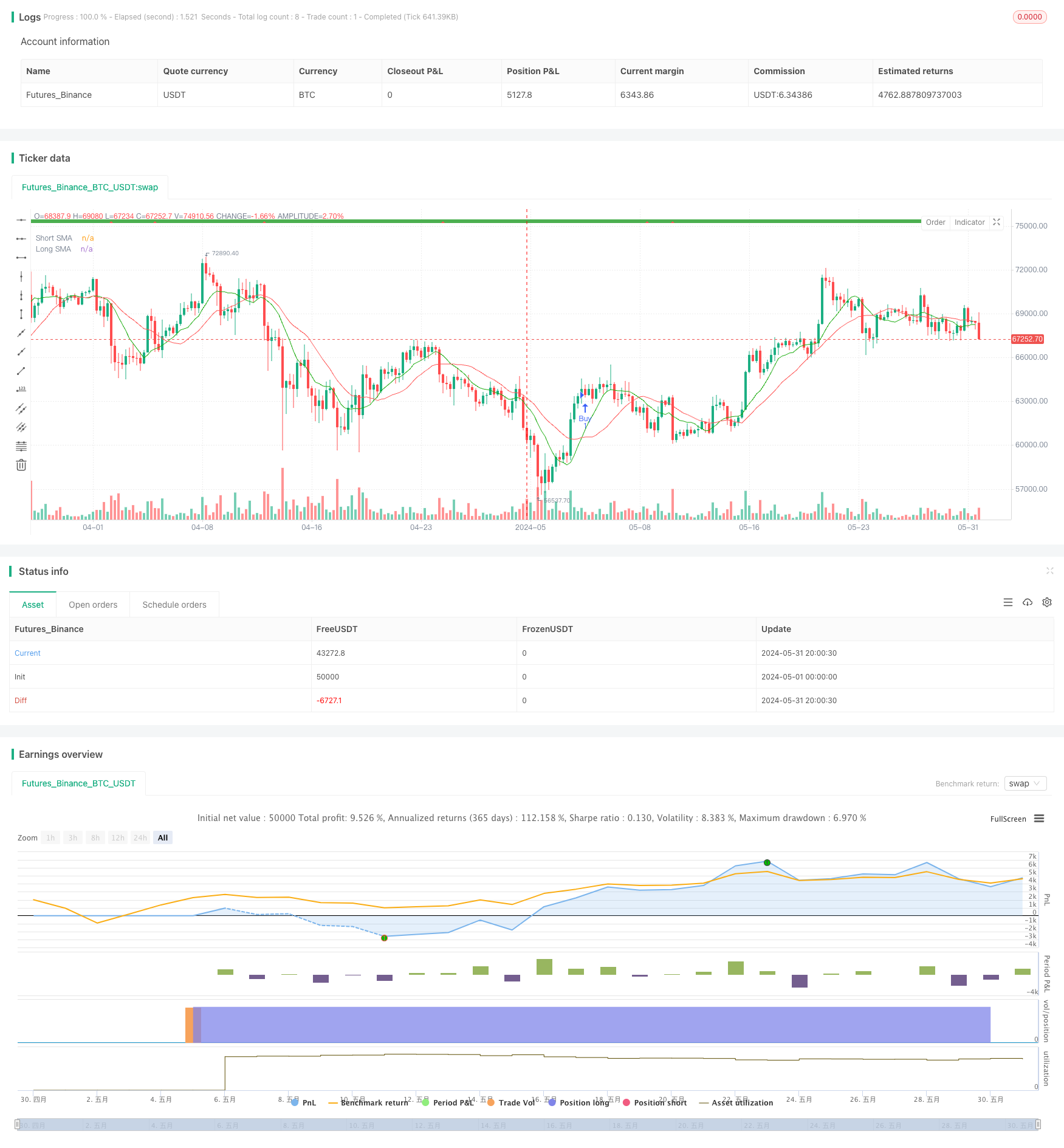
Überblick
Die Strategie basiert auf einfachen Moving Averages (SMA) auf verschiedenen Zeitskalen, um Markttrends zu erfassen. Sie erzeugt Kauf- und Verkaufssignale durch den Vergleich der relativen Position von kurz- und langfristigen SMAs. Die Strategie verwendet zugleich Trendbestätigungsbedingungen, um falsche Signale zu filtern und die Handelsgenauigkeit zu verbessern.
Strategieprinzip
- Berechnung von kurz- und langfristigen SMAs, um die Richtung der Markttrends zu bestimmen.
- Wenn ein kurzer SMA einen langen SMA durchläuft, wird ein Kaufsignal erzeugt. Wenn ein kurzer SMA einen langen SMA durchläuft, wird ein Verkaufsignal erzeugt.
- Die Trendbestätigungsbedingungen werden verwendet, um falsche Signale zu filtern. Kaufen wird nur ausgeführt, wenn der Haupttrend mehrköpfig ist, und Verkaufen wird nur ausgeführt, wenn der Haupttrend leer ist.
- Setzen Sie Stop-and-Loss-Funktionen, um das Handelsrisiko zu kontrollieren. Befreien Sie sich von der Position, wenn der Preis das vorgegebene Stop- oder Stop-Loss-Niveau erreicht.
- Dynamische Anpassung der Positionen an die Trendbestätigung. Befreien Sie sich von Verlusten, die durch eine Trendwende verursacht werden, wenn sich der Haupttrend ändert.
Strategische Vorteile
- Trend-Tracking: Die Strategie basiert auf SMAs auf verschiedenen Zeitskalen und kann die wichtigsten Trends des Marktes effektiv erfassen und sich an unterschiedliche Marktbedingungen anpassen.
- Trendbestätigung: Durch die Einführung von Trendbestätigungsbedingungen werden Falschsignale gefiltert, die Zuverlässigkeit von Handelssignalen erhöht und ungültige Geschäfte reduziert.
- Risikomanagement: Eingebettete Stop-Loss-Funktionen, die helfen, die Risiken des Handels zu kontrollieren und die Sicherheit der Gelder der Anleger zu schützen.
- Dynamische Anpassung: Dynamische Anpassung der Positionen nach der Bestätigung des Trends, um rechtzeitig auf Marktveränderungen zu reagieren und die Verluste durch eine Trendwende zu verringern.
Strategisches Risiko
- Parameteroptimierungsrisiken: Die Performance der Strategie hängt von der Wahl der Parameter für den SMA-Zyklus und die Stop-Loss-Gleichgewichtsparameter ab. Die falsche Einstellung der Parameter kann zu einer schlechten Strategieeffektivität führen.
- Schwankungsrisiko: In einem schwankenden Marktumfeld können häufige Handelssignale zu Überhändlungen führen, die die Kosten und das Risiko für den Handel erhöhen.
- Das Risiko eines unerwarteten Ereignisses: Im Falle eines unerwarteten Ereignisses, bei dem die Märkte stark schwanken können, kann die Strategie nicht rechtzeitig eingesetzt werden, was zu größeren Verlusten führt.
Richtung der Strategieoptimierung
- Einführung von mehr technischen Indikatoren: In Kombination mit anderen technischen Indikatoren wie MACD, RSI und anderen, verbessert die Genauigkeit und Stabilität der Trendbeurteilung.
- Optimierung der Parameterwahl: Suche nach der optimalen SMA-Periode durch historische Datenrückverfolgung und Parameteroptimierung. Stop-Loss-Equilibrium-Parameterkombination, Verbesserung der Strategieperformance.
- Verbesserung des Risikomanagements: Die Einführung von fortgeschritteneren Risikomanagementtechniken wie Dynamic Stop Losses, Positionsmanagement usw. führt zu einer weiteren Kontrolle der Risikothek.
- Anpassung an unterschiedliche Marktbedingungen: Strategieparameter werden dynamisch angepasst, um die Strategie an unterschiedliche Marktbedingungen anzupassen, je nach Marktvolatilität und Trendstärke.
Zusammenfassen
Die Multi-Zeitskala SMA Trend Tracking und Dynamische Stop-Strategie nutzt die unterschiedlichen Zeitskalen der SMA Markttrends zu erfassen, durch Trend Bestätigung Bedingungen zu filtern falsche Signale, während die Einstellung Stop-Loss und Dynamische Positionsanpassung Funktion, die Ziele der Trend-Tracking und Risikomanagement erreicht. Obwohl die Strategie hat einige Vorteile, aber immer noch mit Parameter Optimierung, Schaukel-Markt und Unvorhergesehene Risiken.
/*backtest
start: 2024-05-01 00:00:00
end: 2024-05-31 23:59:59
period: 6h
basePeriod: 15m
exchanges: [{"eid":"Futures_Binance","currency":"BTC_USDT"}]
*/
//@version=5
strategy("market slayer v3", overlay=true)
// Input parameters
showConfirmationTrend = input(title='Show Trend', defval=true)
confirmationTrendTimeframe = input.timeframe(title='Main Trend', defval='240')
confirmationTrendValue = input(title='Main Trend Value', defval=2)
showConfirmationBars = input(title='Show Confirmation Bars', defval=true)
topCbarValue = input(title='Top Confirmation Value', defval=60)
short_length = input.int(10, minval=1, title="Short SMA Length")
long_length = input.int(20, minval=1, title="Long SMA Length")
takeProfitEnabled = input(title="Take Profit Enabled", defval=false)
takeProfitValue = input.float(title="Take Profit (points)", defval=20, minval=1)
stopLossEnabled = input(title="Stop Loss Enabled", defval=false)
stopLossValue = input.float(title="Stop Loss (points)", defval=50, minval=1)
// Calculate SMAs
short_sma = ta.sma(close, short_length)
long_sma = ta.sma(close, long_length)
// Generate buy and sell signals based on SMAs
buy_signal = ta.crossover(short_sma, long_sma)
sell_signal = ta.crossunder(short_sma, long_sma)
// Plot SMAs
plot(short_sma, color=color.rgb(24, 170, 11), title="Short SMA")
plot(long_sma, color=color.red, title="Long SMA")
// Confirmation Bars
f_confirmationBarBullish(cbValue) =>
cBarClose = close
slowConfirmationBarSmaHigh = ta.sma(high, cbValue)
slowConfirmationBarSmaLow = ta.sma(low, cbValue)
slowConfirmationBarHlv = int(na)
slowConfirmationBarHlv := cBarClose > slowConfirmationBarSmaHigh ? 1 : cBarClose < slowConfirmationBarSmaLow ? -1 : slowConfirmationBarHlv[1]
slowConfirmationBarSslDown = slowConfirmationBarHlv < 0 ? slowConfirmationBarSmaHigh : slowConfirmationBarSmaLow
slowConfirmationBarSslUp = slowConfirmationBarHlv < 0 ? slowConfirmationBarSmaLow : slowConfirmationBarSmaHigh
slowConfirmationBarSslUp > slowConfirmationBarSslDown
fastConfirmationBarBullish = f_confirmationBarBullish(topCbarValue)
fastConfirmationBarBearish = not fastConfirmationBarBullish
fastConfirmationBarClr = fastConfirmationBarBullish ? color.green : color.red
fastConfirmationChangeBullish = fastConfirmationBarBullish and fastConfirmationBarBearish[1]
fastConfirmationChangeBearish = fastConfirmationBarBearish and fastConfirmationBarBullish[1]
confirmationTrendBullish = request.security(syminfo.tickerid, confirmationTrendTimeframe, f_confirmationBarBullish(confirmationTrendValue), lookahead=barmerge.lookahead_on)
confirmationTrendBearish = not confirmationTrendBullish
confirmationTrendClr = confirmationTrendBullish ? color.green : color.red
// Plot trend labels
plotshape(showConfirmationTrend, style=shape.square, location=location.top, color=confirmationTrendClr, title='Trend Confirmation Bars')
plotshape(showConfirmationBars and (fastConfirmationChangeBullish or fastConfirmationChangeBearish), style=shape.triangleup, location=location.top, color=fastConfirmationChangeBullish ? color.green : color.red, title='Fast Confirmation Bars')
plotshape(showConfirmationBars and buy_signal and confirmationTrendBullish, style=shape.triangleup, location=location.top, color=color.green, title='Buy Signal')
plotshape(showConfirmationBars and sell_signal and confirmationTrendBearish, style=shape.triangledown, location=location.top, color=color.red, title='Sell Signal')
// Generate trade signals
buy_condition = buy_signal and confirmationTrendBullish and not (strategy.opentrades > 0)
sell_condition = sell_signal and confirmationTrendBearish and not (strategy.opentrades > 0)
strategy.entry("Buy", strategy.long, when=buy_condition, comment ="BUY CALLS")
strategy.entry("Sell", strategy.short, when=sell_condition, comment ="BUY PUTS")
// Take Profit
if (takeProfitEnabled)
strategy.exit("Take Profit Buy", from_entry="Buy", profit=takeProfitValue)
strategy.exit("Take Profit Sell", from_entry="Sell", profit=takeProfitValue)
// Stop Loss
if (stopLossEnabled)
strategy.exit("Stop Loss Buy", from_entry="Buy", loss=stopLossValue)
strategy.exit("Stop Loss Sell", from_entry="Sell", loss=stopLossValue)
// Close trades based on trend confirmation bars
if strategy.opentrades > 0
if strategy.position_size > 0
if not confirmationTrendBullish
strategy.close("Buy", comment ="CLOSE CALLS")
else
if not confirmationTrendBearish
strategy.close("Sell", comment ="CLOSE PUTS")
// Define alert conditions as booleans
buy_open_alert = buy_condition
sell_open_alert = sell_condition
buy_closed_alert = strategy.opentrades < 0
sell_closed_alert = strategy.opentrades > 0
// Alerts
alertcondition(buy_open_alert, title='Buy calls', message='Buy calls Opened')
alertcondition(sell_open_alert, title='buy puts', message='buy Puts Opened')
alertcondition(buy_closed_alert, title='exit calls', message='exit calls ')
alertcondition(sell_closed_alert, title='exit puts', message='exit puts Closed')